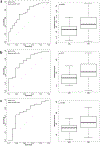Clinical utility of radiomics at baseline rectal MRI to predict complete response of rectal cancer after chemoradiation therapy
- PMID: 32296896
- PMCID: PMC7572430
- DOI: 10.1007/s00261-020-02502-w
Clinical utility of radiomics at baseline rectal MRI to predict complete response of rectal cancer after chemoradiation therapy
Abstract
Purpose: To investigate the value of T2-radiomics combined with anatomical MRI staging criteria from pre-treatment rectal MRI in predicting complete response to neoadjuvant chemoradiation therapy (CRT).
Methods: This retrospective study included patients with locally advanced rectal cancer who underwent rectal MRI before neoadjuvant CRT from October 2011 to January 2015 and then surgery. Surgical histopathologic analysis was used as the reference standard for pathologic complete response. Anatomical MRI staging criteria were extracted from our institutional standardized radiology report. In radiomics analysis, one radiologist manually segmented the primary tumor on T2-weighted images for all 102 patients (i.e., training set); two different radiologists independently segmented 66/102 patients (i.e., validation set). 108 radiomics features were extracted. Then, scanner-independent features were identified and least absolute shrinkage operator analysis was used to extract a radiomics score. Finally, a support vector machine model combining the radiomics score and anatomical MRI staging criteria was compared against both anatomical MRI-only and radiomics-only models using the deLong test.
Results: The study included 102 patients (42 women; median age = 61 years).The radiomics score produced an area under the curve (AUC) of 0.75. Comparable results were found using the validation set (AUCs = 0.75 and 0.71 for each radiologist, respectively). The anatomical MRI-only model had an accuracy of 67% (sensitivity 42%, specificity 72%); when adding the radiomics score, the accuracy increased to 74% (sensitivity 58%, specificity 77%).
Conclusion: Combining T2-radiomics and anatomical MRI staging criteria from pre-treatment rectal MRI may help to stratify patients based on the prediction of treatment response to neoadjuvant therapy.
Keywords: Computer-assisted; Image interpretation; Magnetic resonance imaging; Rectal cancer; Treatment outcome.
Conflict of interest statement
Figures




References
-
- Maas M, Nelemans PJ, Valentini V, Das P, Rodel C, Kuo LJ, Calvo FA, Garcia-Aguilar J, Glynne-Jones R, Haustermans K, Mohiuddin M, Pucciarelli S, Small W Jr., Suarez J, Theodoropoulos G, Biondo S, Beets-Tan RG, Beets GL (2010) Long-term outcome in patients with a pathological complete response after chemoradiation for rectal cancer: a pooled analysis of individual patient data. The Lancet Oncology 11 (9):835–844. doi:10.1016/s1470-2045(10)70172-8 - DOI - PubMed
-
- Renehan AG, Malcomson L, Emsley R, Gollins S, Maw A, Myint AS, Rooney PS, Susnerwala S, Blower A, Saunders MP, Wilson MS, Scott N, O’Dwyer ST (2016) Watch-and-wait approach versus surgical resection after chemoradiotherapy for patients with rectal cancer (the OnCoRe project): a propensity-score matched cohort analysis. The Lancet Oncology 17 (2):174–183. doi:10.1016/s1470-2045(15)00467-2 - DOI - PubMed
-
- Maas M, Lambregts DM, Nelemans PJ, Heijnen LA, Martens MH, Leijtens JW, Sosef M, Hulsewe KW, Hoff C, Breukink SO, Stassen L, Beets-Tan RG, Beets GL (2015) Assessment of Clinical Complete Response After Chemoradiation for Rectal Cancer with Digital Rectal Examination, Endoscopy, and MRI: Selection for Organ-Saving Treatment. Annals of surgical oncology 22 (12):3873–3880. doi:10.1245/s10434-015-4687-9 - DOI - PMC - PubMed
-
- van der Sande ME, Beets GL, Hupkens BJ, Breukink SO, Melenhorst J, Bakers FC, Lambregts DM, Grabsch HI, Beets-Tan RG, Maas M (2019) Response assessment after (chemo)radiotherapy for rectal cancer: Why are we missing complete responses with MRI and endoscopy? European journal of surgical oncology : the journal of the European Society of Surgical Oncology and the British Association of Surgical Oncology 45 (6):1011–1017. doi:10.1016/j.ejso.2018.11.019 - DOI - PubMed
-
- Horvat N, Veeraraghavan H, Pelossof RA, Fernandes MC, Arora A, Khan M, Marco M, Cheng CT, Gonen M, Golia Pernicka JS, Gollub MJ, Garcia-Aguillar J, Petkovska I (2019) Radiogenomics of rectal adenocarcinoma in the era of precision medicine: A pilot study of associations between qualitative and quantitative MRI imaging features and genetic mutations. European journal of radiology 113:174–181. doi:10.1016/j.ejrad.2019.02.022 - DOI - PMC - PubMed
Publication types
MeSH terms
Grants and funding
LinkOut - more resources
Full Text Sources
Research Materials

